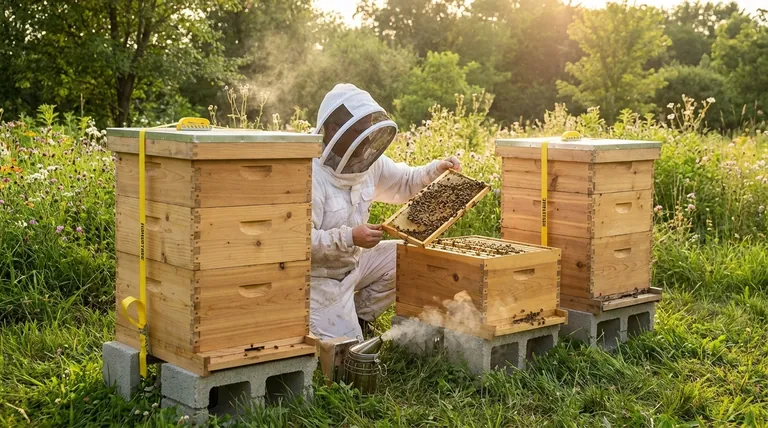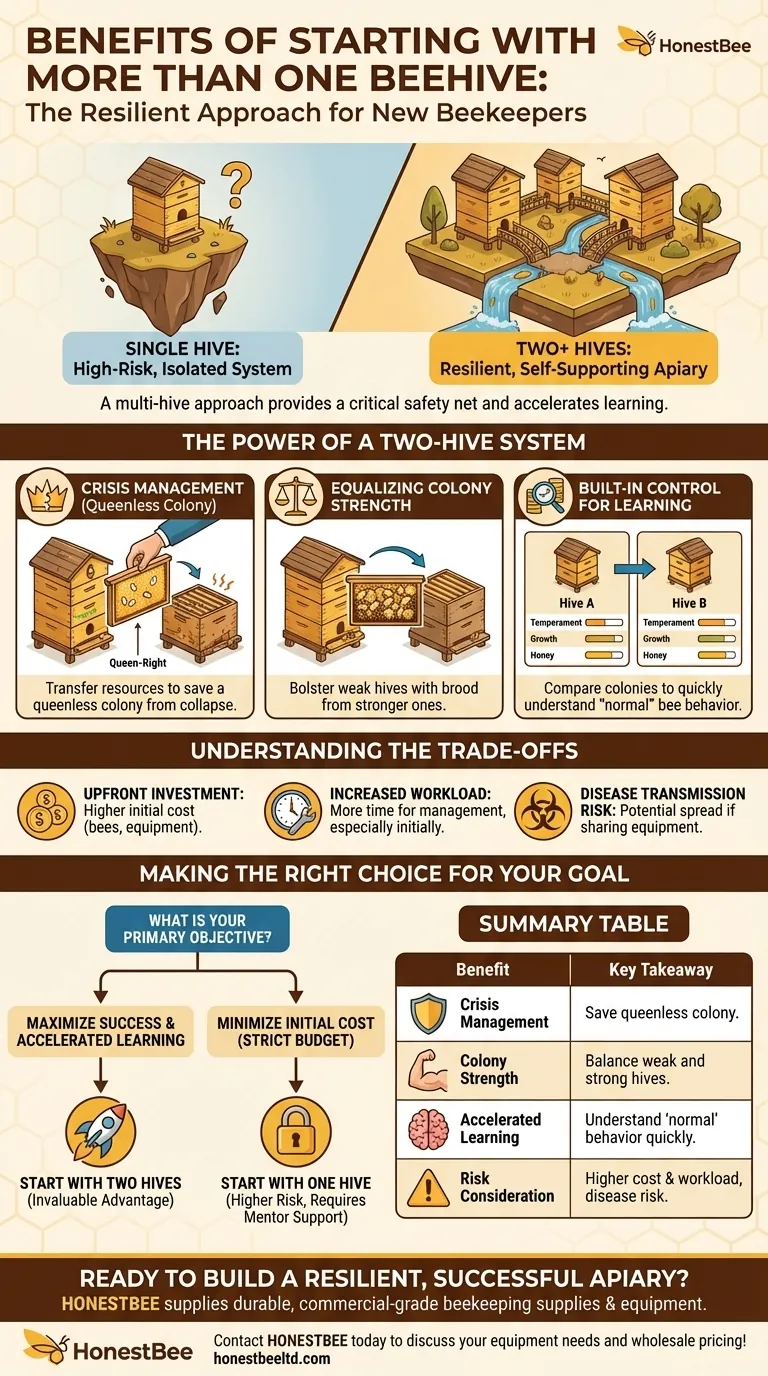To put it simply, starting with at least two beehives dramatically increases your chances of success as a new beekeeper. It provides a safety net by allowing you to share resources between the colonies, which can correct common problems that would otherwise lead to a total loss. This multi-hive approach also accelerates your learning by giving you a baseline for comparison.
The core decision isn't about having one hive versus two; it's about choosing between a high-risk, isolated system and a resilient, self-supporting apiary. Starting with two hives is one of the most effective forms of insurance in beekeeping.

The Power of a Two-Hive System
A single beehive is an island. If it runs into trouble, it has no external support. A second hive acts as a "sister colony," providing critical resources and insights that make managing your bees far more forgiving.
Solving the Queenless Crisis
One of the most common and fatal issues for a new hive is losing its queen. A colony that is queenless cannot produce new eggs and will eventually perish.
With a second, queen-right hive, you have a simple solution. You can transfer a frame of fresh eggs and young larvae from the healthy colony to the queenless one. The bees in the struggling hive will use these resources to raise a new emergency queen, saving the colony from collapse.
Equalizing Colony Strength
It's common for one hive to be significantly stronger than another. The stronger hive may build up faster, gather more nectar, and have a larger population.
A weak hive is vulnerable to pests, diseases, and robbing from other bees. You can bolster a weak hive by giving it a frame of capped brood (developing bees) from your stronger colony. This infusion of new bees helps the weaker colony defend itself and grow its population more quickly.
A Built-in Control for Learning
For a new beekeeper, it's difficult to know what "normal" looks like. Is your hive building up too slowly? Is the queen's laying pattern healthy? Are the bees behaving aggressively?
Having two hives provides an immediate point of comparison. You can observe differences in temperament, population growth, and honey production. This comparative insight is one of the fastest ways to build your intuition and understand the natural variations between colonies.
Understanding the Trade-offs
While the benefits are substantial, it's important to acknowledge the practical considerations of starting with more than one hive. Objectivity is key to making a sustainable choice.
The Upfront Investment
The most significant barrier is cost. Starting with two hives means doubling your initial investment in bees, hive boxes, frames, and foundation. This can be a considerable expense when you are just entering the hobby.
Increased Initial Workload
Managing two hives naturally requires more time than managing one, especially during initial setup and inspections. While this workload often becomes more efficient over time, the initial demand is higher.
The Risk of Disease Transmission
If one hive develops a disease, there is a risk of transmitting it to the other, especially if you are sharing frames and equipment. Proper sanitation and careful inspection techniques are essential to mitigate this risk, but it is a factor to be aware of.
Making the Right Choice for Your Goal
Your decision should align with your primary objective for getting into beekeeping. There is no single "correct" answer, only the one that is right for your situation.
- If your primary focus is maximizing your chances of success and accelerating your learning: Start with two hives. The ability to correct problems and compare colonies is an invaluable advantage that far outweighs the initial cost.
- If your primary focus is minimizing initial cost due to a strict budget: Starting with one hive is possible, but you must do so with a clear understanding of the higher risk. In this scenario, it is critical to join a local beekeeping club and find a mentor who can provide support and potentially resources if your single colony runs into trouble.
Ultimately, a two-hive system transforms beekeeping from a gamble into a manageable and far more rewarding endeavor.
Summary Table:
| Benefit | Key Takeaway |
|---|---|
| Crisis Management | A second hive provides resources to save a queenless colony from collapse. |
| Colony Strength | Balance weak and strong hives by sharing frames of capped brood. |
| Accelerated Learning | Compare colonies to quickly understand what is 'normal' bee behavior. |
| Risk Consideration | Higher initial investment and workload, with a risk of disease transmission. |
Ready to build a resilient, successful apiary? As a new beekeeper, having the right equipment is crucial for managing multiple hives effectively. HONESTBEE supplies durable, commercial-grade beekeeping supplies and equipment to serious beekeepers and distributors through wholesale-focused operations. Let us help you build a strong foundation for your beekeeping journey.
Contact HONESTBEE today to discuss your equipment needs and wholesale pricing!
Visual Guide

Related Products
- Professional Galvanized Hive Strap with Secure Locking Buckle for Beekeeping
- Heavy-Duty Nylon Beehive Hive Strap with Stainless Steel Cinch Buckle
- Jenter Queen Rearing Kit Complete Set for Bee Breeding
- No Grafting Queen Rearing Kit: System for Royal Jelly Production and Queen Rearing
- Plastic Handle Single Row Artificial Fiber Bee Brush
People Also Ask
- How can beekeepers secure the top cover of a hive? Protect Your Colony from Wind and Weather
- How should a cam buckle strap be installed for optimal performance? Master the Leverage for Maximum Tension
- Can straps with hook ends be used for beehives? A Guide to Secure Hive Management
- What is the advantage of using cam buckle straps? Secure Your Load Fast with Simple, Safe Tensioning
- Why are hive straps important for beekeepers? Secure Your Hives Against Wind, Predators & Transport



















